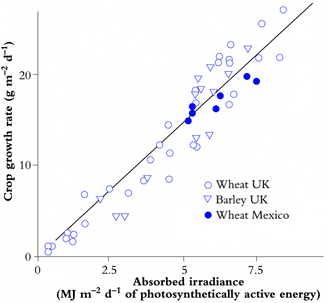Preliminary Course.
Eco-Physiology
Photosynthesis
Light Use Efficiency
-
In agronomy, biomass production is simply quantified by weight.
-
It has been shown that the biomass growth rate, expressed in grams of dry matter per square metre per
day (g.m-2.d-1) is linearly related to the irradiance absorbed (MJ.m-2.d-1)
for a wide range of plant communities.
The relationship between biomass and absorbed irradiance (PAR) defines Light Use Efficiency, abbreviated as LUE.
Note. When considering total irradiance, this ratio is called Radiation Light Use Efficiency, abbreviated as RUE.

Light Use Efficiency on common crops.
Light Use Efficiency (in g.MJ-1) is represented by the slope of this relationship.
It is equivalent to 3 g.MJ-1 in this example (based on Evans 1993).
Definition
LUE (Light Use Efficiency)
Physiology (abrev.). LUE defines the conversion factor between the daily dry biomass production, expressed in gramme per squere meter per day and the absorbed irradiance (PAR) expressed in Mega Joule per square meter per day. Unit: g.MJ-1. See also: PAR, RUEDefinition
PAR (Photosynthetically Active Radiation)
Physiology (abrev.). PAR defines the wave band of solar radiation that plants are able to use in the process of photosynthesis. In agronomy, PAR is usually expressed in energy units as an irradiance per area. Unit: W.m-2.Definition
